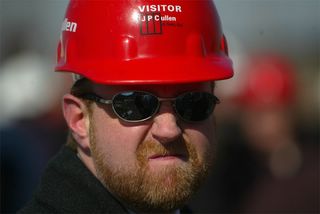 I don't want to appear too much of a tourist when I visit LONDON later this year.
I don't want to appear too much of a tourist when I visit LONDON later this year.
That's why I am honing my pronunciation of certain place names.
I already knew that KEIGHLY up in the north of the country is actually pronounced "KEETH-lee," and even many non-Anglophiles know LEICESTER is pronounced "LEHS-ster."
Those two examples, however, cannot prepare one to know how to pronounce LEIGH. Is it "LEETH?" Is it "LEH?"
It's neither. It's "LIE."
So why do the English pronounce TEIGNMOUTH as "tin-MUTH?"
I haven't got a clue.
Everyone knows READING is "RED-DING," like the town in California.
Did you know the Norfolk town of HAPPISBURGH is actually pronounced "HAZE-burr?"
Hmm! Is that a fact?
Truthfully, there appears to be no rhyme nor reason to the pronunciation of English place names. I suppose they can say the words any way they wish. They did invent the language, after all.
SOUTHWARK? Yeah. The area of London pictured is actually pronounced "SUH-thik."
 Whitehall... Oxford Street... Portobello Road...
Whitehall... Oxford Street... Portobello Road...
LONDON seems like a collection of famous roadways.
I hope to grace as many as I can come December.
Park Lane... King's Road... Kensington High Street...
Part of my preparations for London include developing the proper mindset.
I intend to begin some of those particular preparations today, by briefly abandoning "THE ROUGH GUIDE TO LONDON" to read the MONICA ALI novel, BRICK LANE.
Named after a street in the East End heart of London's Bangladeshi community, the novel follows the exploits of Nazneen, a Bangladeshi woman who moves to London at the age of 18 to marry an older man.
How will this help me prepare for London?
I feel the need to get London in my brain and heart.
That's why I am currently listening to EDDY GRANT.
One of the British reggae musician's most famous songs -- reaching No. 2 on the charts on both sides of the Atlantic -- is "ELECTRIC AVENUE."
That's right. It's named after another London street.
Electric Avenue is one of the primary thoroughfares in Brixton. Built in the 1880s, Electric Avenue's early adoption of electric lighting gave the roadway its name.
The street is at the heart of the eclectic Brixton Market, and affirms my contention that London is a collection of famous streets.
 My friend Bekah travels later this month to JAMAICA for her honeymoon, so I made her a CD mix of some of my favorite reggae.
My friend Bekah travels later this month to JAMAICA for her honeymoon, so I made her a CD mix of some of my favorite reggae.
I am doing the same for myself, but instead of the Caribbean, I am going to LONDON in December.
Surprised?
Don't be. Tonight, I am reading about June 22, 1948, when the former troopship, "EMPIRE WINDRUSH," arrived at Tilbury Docks from Jamaica, with 482 Caribbeans on board.
Britain was beginning the slow recovery from war in 1948, and Caribbean immigrants provided much of the labor for the efforts.
Shocked by the climate and not welcomed as warmly as possible, most of the Empire Windrush passengers endured, and in doing so, altered the fabric of modern Britain.
The musical scene was altered as well -- Trinidadian calypso star Lord Kitchener serenaded reporters on the dockside with "London is The Place For Me."
See? It makes perfect sense for me to listen to reggae as I prepare to visit London.
 Now that I have finally secured "THE ROUGH GUIDE TO LONDON" -- thanks Amazon.com! -- I feel like I can finally begin mental preparations for my DECEMBER trip to the English capital.
Now that I have finally secured "THE ROUGH GUIDE TO LONDON" -- thanks Amazon.com! -- I feel like I can finally begin mental preparations for my DECEMBER trip to the English capital.
So, why am I reading about LONDINIUM?
I decided that before I delved into the various sights and locales of London, I would spend some time investigating its lengthy history.
It was about 50 AD when the ROMANS decided to establish a permanent military camp near a fordable point in the THAMES, and Londinium was born.
Londinium enjoyed its greatest prosperity, the "Rough Guide" authors note, between 80 AD and 120 AD. Londinium grew into the Empire's fifth largest city north of the Alps.
The foundations of a Roman amphitheatre -- dating from about 120 AD -- can be seen near the GUILDHALL ART GALLERY in the City.
I want to try to track it down during my trip. Then, I can say I glimpsed Londinium.
 I don't want to appear too much of a tourist when I visit LONDON later this year.
I don't want to appear too much of a tourist when I visit LONDON later this year.


